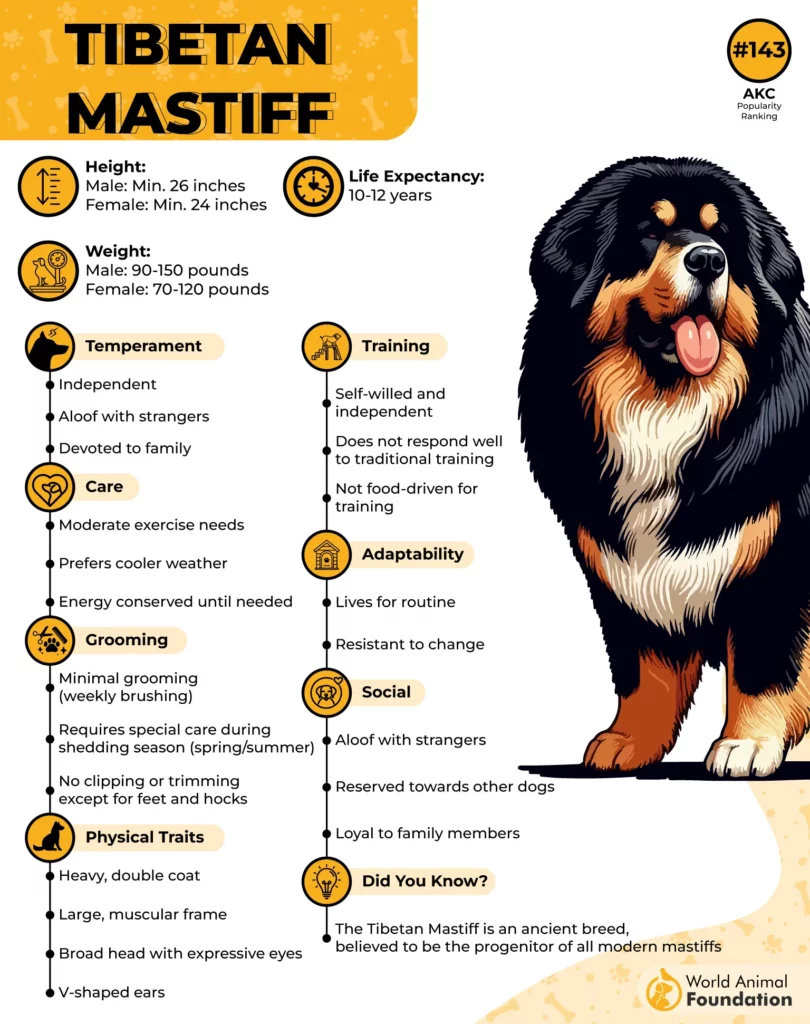When it comes to giant dog breeds with hearts as big as their paws, the Saint Bernard and the Tibetan Mastiff are two top contenders. Though the Saint Bernard doesn’t top the AKC popularity charts, this gentle giant from the Swiss Alps has earned worldwide love for its sweet nature and legendary loyalty, especially around kids. Saints are famously patient, calm, and always ready to keep a watchful eye on the family.
On the flip side, the Tibetan Mastiff is a true guardian spirit—aloof with strangers but fiercely devoted to its own. With their thick coats, noble presence, and territorial instincts, these ancient protectors bring both calm companionship and an unmatched sense of security to the home.
So, when comparing Saint Bernard vs Tibetan Mastiff, which one is better for your family, lifestyle, and space? Let’s dive into their differences in temperament, grooming needs, training, and more to help you decide.
Saint Bernard vs. Tibetan Mastiff
The Saint Bernard hails from the snowy Alps, where it earned its legendary status as a rescue dog. Developed by monks in the 16th and 17th centuries at a hospice founded by Saint Bernard of Menthon, these dogs were bred to help lost travelers navigate the treacherous Great and Little Saint Bernard passes, states Britannica.
With roots tracing back to ancient Roman war dogs like the Molossus, the Saint Bernard evolved into a powerful, gentle giant known for its life-saving instincts. The most famous of them all, Barry, reportedly saved around 40 lives in the early 1800s—earning the breed the affectionate Swiss nickname “Barryhund.”

The Tibetan Mastiff, by contrast, comes from the remote, high-altitude regions of Tibet and boasts one of the oldest and most mysterious lineages in the dog world. Revered as ancient guardians, Tibetan Mastiffs were bred to protect homes, temples, and livestock from predators and intruders. Their isolation in the Himalayas helped preserve their traits—aloof with strangers, deeply loyal to family, and intensely territorial.

First introduced outside Tibet in 1847 as a royal gift to Queen Victoria, they didn’t reach the U.S. until the 1950s and only gained AKC recognition in 2006. Though both breeds descend from ancient mastiff stock, their histories reflect vastly different roles: one a benevolent rescuer, the other a fearless protector.
Size and Weight Differences
The St Bernard is truly a giant among dogs, with males and females alike reaching impressive sizes. Standing up to 30 inches tall at the shoulder and weighing between 120 to 180 pounds, this breed needs plenty of room to stretch out, both indoors and outdoors. Their massive build, combined with their calm demeanor, makes them gentle giants, but potential dog owners should be prepared for the space and strength that come with a dog of this magnitude.

The Tibetan Mastiff is slightly smaller in stature but equally imposing, thanks in part to its thick, lionlike mane and sturdy frame. Adult males typically stand at least 26 inches tall, and the average weight is between 90 to 150 pounds. Females usually measure around 24 inches and weigh between 70 to 120 pounds. Though they may be a bit lighter than Saint Bernards, Tibetan Mastiffs still require a spacious environment and strong handling due to their sheer power and independent nature, states WebMD.

Temperament and Personality Traits
Saint Bernards are known for their calm, affectionate nature and are especially gentle with children, making them a beloved family companion. These people-oriented dogs thrive on companionship and can develop separation anxiety if left alone for too long. While puppies are energetic and playful, adult Saints tend to be low energy and mellow out with age.

They’re generally quiet and get along well with other pets when properly socialized. Though not big barkers, they do have a habit of digging—a leftover instinct from their search-and-rescue past—so supervision outdoors is a must.
On the other hand, Tibetan Mastiffs tend to be more independent and territorial. They’re deeply loyal to their family but naturally aloof and cautious around strangers, requiring careful introductions. While they may seem lazy indoors, often sleeping much of the day, they become more active and alert at night.

These powerful dogs need space to roam and are best suited to homes with a secure yard. Without enough mental and physical stimulation, a bored Tibetan Mastiff may dig, chew, or become destructive.
Trainability and Intelligence
Saint Bernards are intelligent and eager to please, picking up training quickly with patience and positive reinforcement. Early socialization and obedience are essential due to their large size. When well-trained, they are gentle and manageable, but without training, they may accidentally knock over children, jump on guests, or steal food. Their strong family bonds mean they can develop unwanted behaviors like barking or chewing if left alone too long.

Tibetan Mastiffs are equally intelligent but much more independent. They learn fast but often decide when to obey, making traditional training less effective. Not food-driven, they rely on instincts over commands and need a handler they respect. Their recall is unreliable, so they should never be off-leash in unsecured areas.
Energy Levels and Exercise Needs
Despite their size, Saint Bernards have moderate energy levels and don’t require intense daily exercise. A long walk or a half-hour of play is usually enough to keep them content and in shape. That said, they’re always up for more adventure and often enjoy family outings like hikes or camping trips. These gentle giants especially love activities that involve their people, such as pulling children in a cart or participating in drafting events. A Saint thrives on companionship and feels happiest when included in daily life.
Tibetan Mastiffs also have moderate exercise needs but approach activity differently. They prefer practical tasks, like patrolling their property, over structured play like fetch or agility. These dogs conserve their energy and tend to be active in short bursts, especially during cooler weather. While not built for endurance, they’re very alert when needed. Otherwise, they’re content lounging around the house, especially sprawled over air vents in summer or curled up like furry rugs in winter.

Playfulness and Activity Preferences
Saint Bernards may be large and powerful dogs, but their play style is mellow and unhurried. As they mature, their bursts of play become shorter and more deliberate. These affectionate dogs enjoy activities that involve being close to their people, whether it’s playing fetch, going for hikes, or lounging in the snow with kids. They also do well in low-impact activities like carting, drafting, or gentle swimming. While they’re friendly and generally good with other pets, they may be a bit reserved around unfamiliar dogs, preferring calm play over roughhousing.

Tibetan Mastiffs, on the other hand, are more independent in their activity choices and enjoy having a job to do. They aren’t big on traditional games like fetch but love patrolling their territory, walking through snow, or engaging in agility tasks that stimulate both body and mind. With strong guarding instincts, they take naturally to livestock protection and thrive with access to open, fenced-in spaces. While playful in their own right, Tibetan Mastiffs prefer purposeful activity over casual play.
Dietary Needs and Weight Management
Saint Bernards need high-quality, large-breed food appropriate for their life stage. Puppies should stay on large-breed puppy formula until 18–24 months before transitioning to adult food. To reduce bloat risk, feed smaller, frequent meals at floor level and minimize mealtime stress. Portion control and vet guidance are important, and joint plus omega-3 supplements can help support their mobility, states PetMD.
Tibetan Mastiffs grow more slowly and should remain on puppy food until about two years old. Adults and seniors require age-appropriate AAFCO-approved diets, with active dogs needing higher protein and less active dogs needing careful portion control to avoid weight gain. They usually eat twice daily but may skip meals, as they’re not very food-driven. Supplements like glucosamine and omega-3s benefit their joint and skin health.

Health Conditions and Lifespan
Saint Bernards typically live 8–10 years, a shorter lifespan common among giant breeds. Though generally gentle and good-natured, they are predisposed to several serious health concerns.
Gastric Dilatation-Volvulus (Bloat): A life-threatening emergency where the stomach twists.
Hip & Elbow Dysplasia: Leads to joint pain and limited mobility.
Degenerative Myelopathy (DM): Spinal condition causing gradual limb paralysis.
Eyelid Disorders: Entropion and ectropion can impair vision and require surgery.
Dilated Cardiomyopathy (DCM): A heart condition; routine vet checkups are vital.
Heat Sensitivity: Prone to heat stress; needs cool environments in warm months.

Tibetan Mastiffs have a slightly longer lifespan of 10–12 years and are prone to a few hereditary conditions, especially affecting joints and eyes, according to PetMD.
Entropion & Ectropion: Eyelid issues leading to infections, ulcers, and vision problems.
Hip & Elbow Dysplasia: Common in large breeds; causes lameness and joint discomfort.
Hypothyroidism: Reduced thyroid hormone levels that affect metabolism and energy.
Weight Sensitivity: Maintaining a healthy weight is crucial for joint and thyroid health.
Allergies and Grooming Requirements
Saint Bernards come in both long-haired and short-haired varieties, but their grooming needs are quite similar. Weekly brushing helps remove dirt and loose hair, keeping their coat healthy and shiny. During shedding season, which happens twice a year, daily brushing is necessary to manage the heavy hair loss. Occasional bathing keeps them fresh, while regular nail trims prevent discomfort and mobility issues. Overall, Saint Bernards require consistent grooming to maintain their majestic appearance and comfort.
Tibetan Mastiffs have a thick double coat with a woolly undercoat and coarse guard hair, which requires minimal grooming most of the year. Weekly brushing with a slicker or pin brush is sufficient to remove surface dirt and prevent tangles, especially around the tail, mane, and breeches. They shed their undercoat heavily once a year, typically in late spring or summer, when an undercoat rake or de-shedding tool is essential. According to breed standards by the American Kennel Club (AKC), clipping is discouraged except for shaping feet and tidying hocks, making grooming relatively low-maintenance outside the shedding season.

Conclusion
Choosing between a Saint Bernard and a Tibetan Mastiff is a decision best suited for experienced dog owners who understand the unique needs of these rare and majestic breeds. Both dogs bring a loving home filled with loyalty and protection, especially around children and other animals like cats.
While Saint Bernards, with their floppy ears and gentle nature, tend to tolerate family life and interact well with others, Tibetan Mastiffs show an unusual independence and strong guarding instincts. Neither breed is ideal for first-time dog owners, as both require early socialization and consistent training to manage their size and tendencies.
Whether adopting from shelters or choosing a reputable breeder, it’s important to consider that these giant dogs need space, patience, and dedication to thrive. In the end, both breeds make smart, devoted companions when raised in the right environment.


